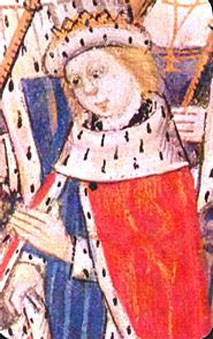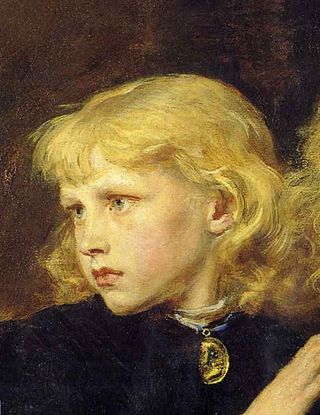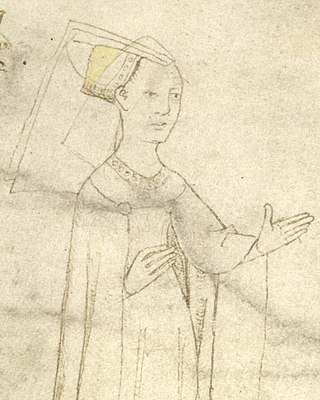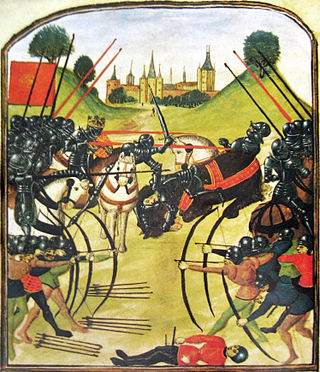Related Research Articles

Richard III was King of England from 26 June 1483 until his death in 1485. He was the last king of the Plantagenet dynasty and its cadet branch the House of York. His defeat and death at the Battle of Bosworth Field, the last decisive battle of the Wars of the Roses, marked the end of the Middle Ages in England.

Edward V was de jure King of England from 9 April to 25 June 1483. He succeeded his father, Edward IV, upon the latter's death. Edward V was never crowned, and his brief reign was dominated by the influence of his uncle and Lord Protector, the Duke of Gloucester, who deposed him to reign as King Richard III; this was confirmed by the Act entitled Titulus Regius, which denounced any further claims through his father's heirs.

Edward IV was King of England from 4 March 1461 to 3 October 1470, then again from 11 April 1471 until his death in 1483. He was a central figure in the Wars of the Roses, a series of civil wars in England fought between the Yorkist and Lancastrian factions between 1455 and 1487.

George Plantagenet, Duke of Clarence, was the sixth son of Richard Plantagenet, 3rd Duke of York, and Cecily Neville, and the brother of English kings Edward IV and Richard III. He played an important role in the dynastic struggle between rival factions of the Plantagenets now known as the Wars of the Roses.

The Princes in the Tower refers to the mystery of the fate of the deposed Edward V of England and his younger brother Richard of Shrewsbury, Duke of York, heirs to the throne of King Edward IV of England. The brothers were the only sons of the king by his queen, Elizabeth Woodville, living at the time of their father's death in 1483. Aged 12 and 9 years old, respectively, they were lodged in the Tower of London by their paternal uncle and England's regent, Richard, Duke of Gloucester, supposedly in preparation for Edward V's forthcoming coronation. Before the young king could be crowned, however, he and his brother were declared illegitimate. Gloucester ascended the throne as Richard III.

Henry Stafford, 2nd Duke of Buckingham, KG was an English nobleman known as the namesake of Buckingham's rebellion, a failed but significant collection of uprisings in England and parts of Wales against Richard III of England in October 1483. He was executed without trial for his role in the uprisings. Stafford is also one of the primary suspects in the disappearance of Richard's nephews, the Princes in the Tower.

Edward of Westminster, also known as Edward of Lancaster, was the only son of Henry VI of England and Margaret of Anjou. He was killed aged seventeen at the Battle of Tewkesbury.

William Hastings, 1st Baron Hastings KG was an English nobleman. A loyal follower of the House of York during the Wars of the Roses, he became a close friend and one of the most important courtiers of King Edward IV, whom he served as Lord Chamberlain. At the time of Edward's death he was one of the most powerful and richest men in England. He was executed following accusations of treason by Edward's brother and ultimate successor, Richard III. The date of his death is disputed; early histories give 13 June, which is the traditional date.

Henry Holland, 3rd Duke of Exeter, 3rd Earl of Huntington was a Lancastrian leader during the English Wars of the Roses. He was the only son of John Holland, 2nd Duke of Exeter, and his first wife, Anne Stafford. His maternal grandparents were Edmund Stafford, 5th Earl of Stafford, and Anne of Gloucester.

Richard of Shrewsbury, Duke of York, was the sixth child and second son of King Edward IV of England and Elizabeth Woodville, born in Shrewsbury. Richard and his older brother, who briefly reigned as King Edward V of England, mysteriously disappeared shortly after their uncle Richard III became king in 1483.

Edward of Middleham, Prince of Wales, was the son and heir apparent of King Richard III of England by his wife Anne Neville. He was Richard's only legitimate child and died aged seven or ten.

John de la Pole, Earl of Lincoln was a leading figure in the Yorkist aristocracy during the Wars of the Roses.

Anne Beauchamp, 16th Countess of Warwick was an important late medieval English noblewoman. She was the daughter of Richard Beauchamp, 13th Earl of Warwick, and his second wife, Isabel le Despenser.

Paul Murray Kendall was an American academic and historian, who taught for over 30 years at Ohio University and then, after his retirement, at the University of Kansas.

John Tiptoft, 1st Earl of Worcester KG, was an English nobleman and scholar who served as Lord High Treasurer, Lord High Constable of England and Lord Deputy of Ireland. He was known as "the Butcher of England" to his Tudor detractors.

Louis de Bourbon was Prince-Bishop of Liège from 1456 until his death.

Duchess of Gloucester is the principal courtesy title used by the wife of the Duke of Gloucester. There have been five titles referring to Gloucester since the 14th century. The current duchess is Birgitte, the wife of Prince Richard. He inherited the dukedom on 10 June 1974 upon the death of his father, Prince Henry, the third son of George V.
Augustinian Friary, York was a friary in North Yorkshire, England.

The Wars of the Roses (1455–1487), known at the time and for more than a century after as the Civil Wars, were a series of civil wars fought over control of the English throne in the mid- to late fifteenth century. These wars were fought between supporters of two rival cadet branches of the royal House of Plantagenet: Lancaster and York. The wars extinguished the last male line of the house of Lancaster in 1471, leading to the Tudor family inheriting the Lancastrian claim to the throne. Following the war and the extinction of the last male line of the house of York in 1483, a politically arranged marriage united the Houses of Tudor and York, creating a new royal dynasty which inherited the Yorkist claim as well, thereby resolving the conflict.
Desmond Eric Christopher Seward was an Anglo-Irish popular historian and the author of many books, including biographies of Henry IV of France, Eleanor of Aquitaine, Marie Antoinette, Empress Eugénie and Napoleon's family. He specialised in Britain and France in the late Middle Ages.
References
- ↑ "Notable Books for Adults | Awards & Grants". www.ala.org. Retrieved 12 October 2023.
- ↑ Desmond Seward, The Wars of the Roses, New York: Penguin (1995), p. 261
- ↑ Charles Ross, Richard III, London (1981), p. li, note 95.